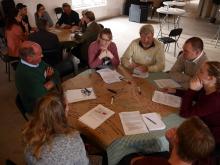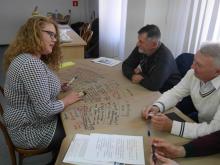Communication to and participation of the public is an important aspect of many planning processes, this also includes the development of DRR plans and strategic alternatives. This description is based on a project handbook that has been especially designed to support regional and local administrations in the planning and implementation of communication and public participation processes in flood prone areas. The findings of this report can also be applied to coastal areas.
Based on: Firus et al (2011): Planning and implementing communication and public participation processes in flood risk management.
These findings are based on a handbook that was published as a result of the project ‘Integrative flood risk governance approach for improvement of risk awareness and increased public participation`(IMRA). The overarching goal of the IMRA project was to influence and change risk perception and real decision-making by actively involving stakeholders and the public in three case study areas of three different river basin districts in Europe. This handbook aims to provide an innovative tool to support in planning, implementing and evaluating a communication and public participation process as part of Flood Risk Management. The active involvement of all interested parties is also stated in the EU Floods Directive (2007).
12 Steps
The described concept is composed of 12 Steps, following a logical and chronological order (see Firus et al. 2011: 8).
Identify your own position
- Step 1: Carry out initial self assessment of risk governance performance
- Step 2: Define goals and scope of process
- Step 3: Identify resources (money, time, personnel)
Identify your strategic partners
- Step 4: Identify relevant stakeholders
- Step 5: Design and define scope of participation process
- Step 6: Create a network of stakeholders
- Step 7: Identify the public’s view
Decide on measures
- Step 8: Agree on objectives
- Step 9: Agree on targeted communication and participation measures
- Step 10: Design an implementation plan for communication and participation measures
Implementation
- Step 11: Implement communication and participation measures
Evaluation
- Step 12: Evaluate the process
The handbook fleshes out the different steps, for example how to select proper stakeholder for participatory processes (in Step 4), describing in more detail what kind of roles stakeholder can take (in Step 5), or how to deal with different social milieus (Step 9).
Methods
In the second part of the handbook, innovative and well-proven communication and participation methods are presented. Within the project, these have been highly suitable for a communication and participation process in flood risk management. The authors describe 16 different methods with respect to their purpose, area of application, aim of the method and context, target group, scale of application, costs, necessary skills, expected results, assessment of results, or key references.
As one example of methods, the world café is described here in more detail. The World Café method is quite well established and its main aim is that people get in contact with each other, discuss and develop new ideas by the power of networking with a multitude of people. It can be used for strategic dialogue, multi-stakeholder engagement, multi-generational collaboration and cooperative action. Participants are seated on Café-style tables and are encouraged by the table host to write, doodle and draw key ideas on their tablecloths. Several rounds of the tables can be undertaken. Finally a period of sharing discoveries and insights in a whole group sums up the initiative.
Practical recommendations when planning and implementing a communication and participation process:
- Make a priority list and tackle the most important issues first.
- Make people feel concerned: they must understand that DRR is something that really is relevant for them and not just an administrative exercise.
- Involve people emotionally (positively!), e.g. by involving witnesses. But: do not make people afraid but raise awareness.
- Choose the right method for the respective target group as people have different social backgrounds and act in different social networks.
- Provide some striking/prominent examples/people.
- Be aware that your manpower and money are limited resources; the effectiveness of measures is important.
- Evaluate your communication material and public participation methods.












